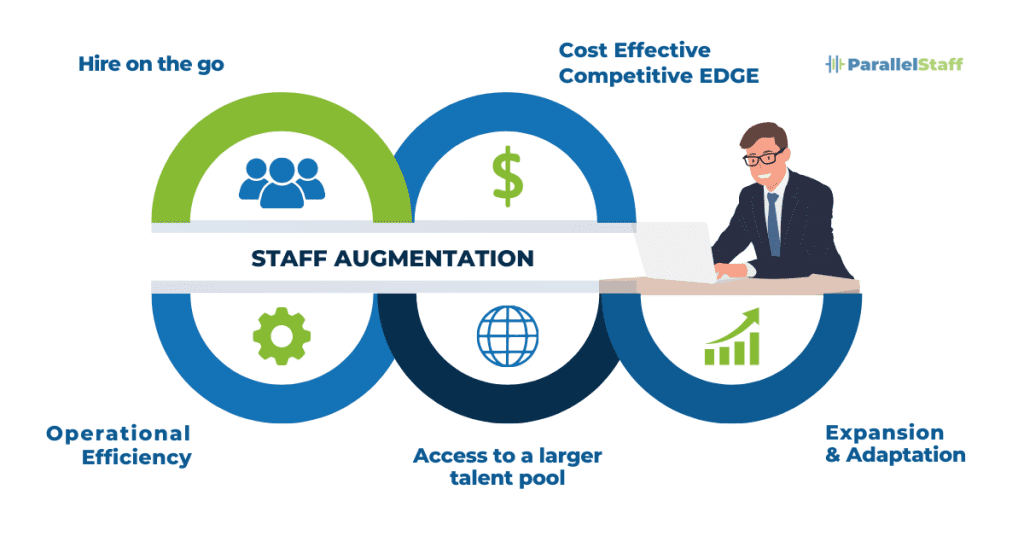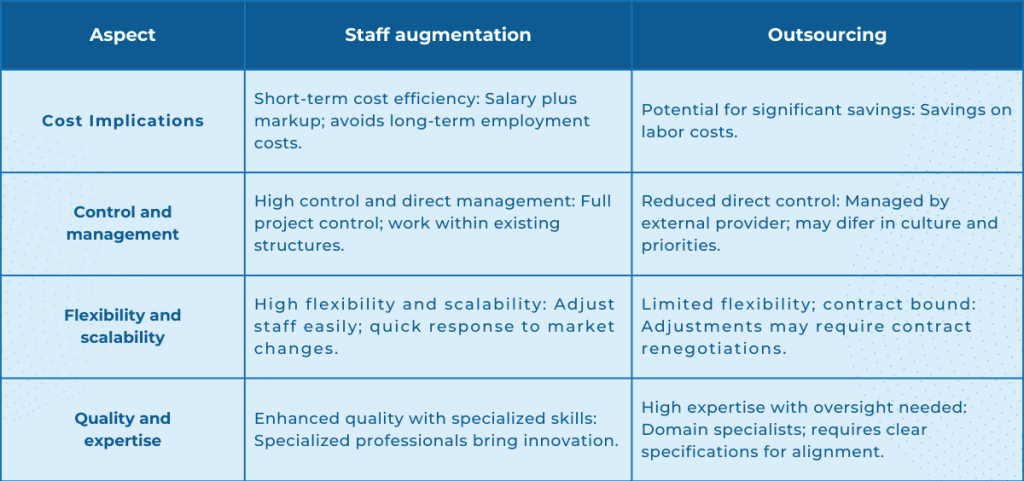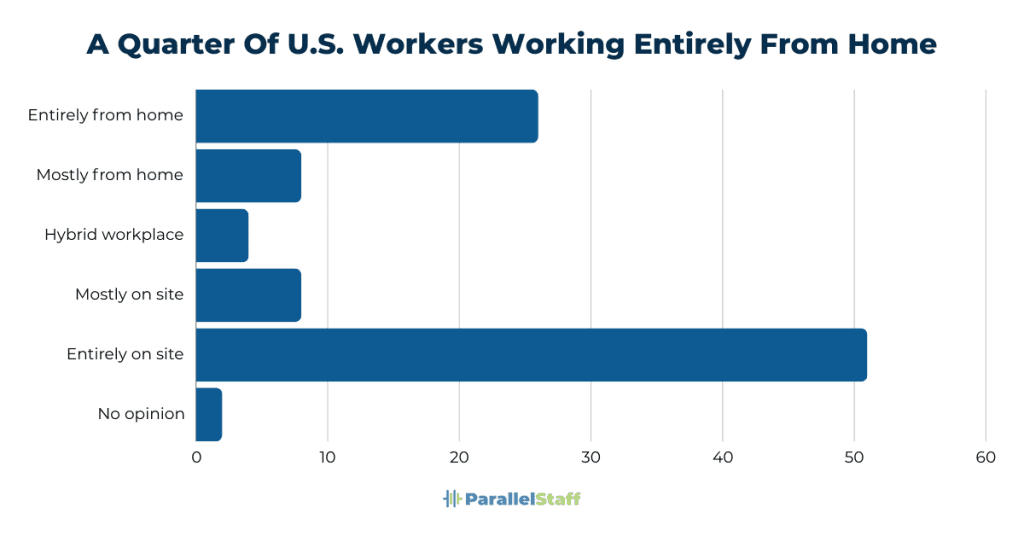Boost Your Team’s Power: Exploring IT Staff Augmentation Strategies
Tech & Business
Read Time: 15 mins

Navigating the complexities of IT project management and team composition calls for a nuanced approach, especially in an era when technological demands can outpace available in-house talent. IT staff augmentation emerges as a strategic compass for businesses looking to strengthen their teams with specialized skills and competencies.
This method fills skill gaps and brings flexibility, innovation, and a global perspective to projects, allowing businesses to achieve their targets more effectively and efficiently.
For IT leaders traversing complex digital waters, staff augmentation can significantly improve their teams' ability to complete projects with precision, speed, and cost-effectiveness. It represents a shift away from traditional hiring models and toward a more dynamic, project-focused approach that meets the needs of today's businesses seeking agility and competitive advantage.
Whether the goal is to shorten development cycles, integrate new technologies, or manage system upgrades, IT staff augmentation provides a tailored solution to extend team capabilities without the permanent commitment and overhead associated with expanding the full-time workforce.
This guide will examine IT staff augmentation, providing valuable insights into how it can be strategically implemented to empower your team and elevate your projects. By exploring the particulars of this approach, we provide IT leaders with the tools they need for successfully tackling the staffing landscape, ensuring their teams are prepared to face current and future challenges.


 The fundamental distinction between IT project outsourcing and staff augmentation lies in allocating project management responsibilities and accountability for outcomes.
With IT project outsourcing, the external vendor assumes full responsibility for overseeing the project and ensuring its success. Conversely, staff augmentation places the onus of project management and accountability for the results squarely on the shoulders of the in-house team.
The fundamental distinction between IT project outsourcing and staff augmentation lies in allocating project management responsibilities and accountability for outcomes.
With IT project outsourcing, the external vendor assumes full responsibility for overseeing the project and ensuring its success. Conversely, staff augmentation places the onus of project management and accountability for the results squarely on the shoulders of the in-house team.
 For initiatives that require tight collaboration with current teams and continuing strategy alignment, IT staff augmentation tends to be the preferable approach. Outsourcing may be a more straightforward choice for projects with defined objectives and less reliance on internal processes.
Imagine an IT company that needs to migrate client data to the cloud but lacks in-house experience. Staff augmentation allows the organization to temporarily engage cloud migration expertise to operate alongside the existing staff.
This method allows the organization to meet its client commitments more effectively while also providing the in-house team with vital expertise and experience.
For initiatives that require tight collaboration with current teams and continuing strategy alignment, IT staff augmentation tends to be the preferable approach. Outsourcing may be a more straightforward choice for projects with defined objectives and less reliance on internal processes.
Imagine an IT company that needs to migrate client data to the cloud but lacks in-house experience. Staff augmentation allows the organization to temporarily engage cloud migration expertise to operate alongside the existing staff.
This method allows the organization to meet its client commitments more effectively while also providing the in-house team with vital expertise and experience.

Understanding the Concept of IT Staff Augmentation
IT staff augmentation is a strategic approach to workforce management that allows businesses to hire external professionals on an as-needed basis. Unlike traditional recruitment processes, which are often geared toward long-term employment, staff augmentation is intended to be flexible and immediate. It allows businesses to address specific skill gaps or augment their teams for particular projects without the long-term commitment and financial burden associated with permanent hires. The emphasis on adaptability and project-specific knowledge distinguishes IT staff augmentation from traditional hiring. Organizations can fine-tune their teams in real-time by adding or removing skilled professionals based on the project's scope, timeline, and technical specifications. This level of adaptability is invaluable for businesses looking to stay agile in a competitive market, allowing them to tap into global talent pools and integrate specialist skills quickly and seamlessly. Furthermore, staff augmentation is more than a temporary fix for skill shortages; it is a conduit for innovation and diversity of thought. Companies can foster a dynamic environment of learning and creativity by bringing together professionals from various backgrounds and areas of expertise, enriching their projects and increasing their overall competitive edge.Key features of IT staff augmentation include
- Flexibility and Scalability: Businesses can adjust their workforce to meet real-time project needs and strategic goals, ensuring optimal resource allocation.
- Access to Global Talent: By tapping into a global pool of professionals, businesses can source rare and in-demand skills without regard for geography.
- Cost Efficient: By avoiding the time-consuming and expensive process of traditional hiring, organizations can better manage budget allocations, focusing on project execution rather than overhead.
- Speed to Market: By quickly onboarding skilled professionals, businesses can shorten project timelines and gain a competitive advantage.
Importance of IT Staff Augmentation in Modern Businesses
In an era characterized by fast technological evolution and shifting market dynamics, the ability to quickly adapt and scale IT functions is not only advantageous but also necessary. IT staff augmentation has become a critical strategy for businesses looking to maintain technological leadership and operational agility. According to SpendEdge, companies worldwide will spend $81 billion on staff augmentation by 2025. It is becoming a cornerstone of workforce strategy to tap into specialized skills and other strategic benefits, which we will discuss later in this article. The integration of IT staff augmentation into the strategic planning of modern businesses is not a trend but a reflection of a broader shift towards agility, efficiency, and innovation in the digital age.Benefits of IT Staff Augmentation
Using IT staff augmentation offers many advantages that address key IT department issues. This approach revolutionizes how companies handle their staff and carry out projects, providing worldwide access to a diverse talent pool and enhancing operational agility.
Access to the Global Talent Pool
One significant advantage of IT staff augmentation is having access to a vast pool of talented individuals worldwide. This allows businesses to easily find top personnel for their projects without being limited by local talent markets. For example, imagine a software company in Silicon Valley that needs to integrate cutting-edge machine learning algorithms into its product. Through staff augmentation, they can quickly hire a machine learning specialist from nearshore, South America, who provides valuable expertise and helps accelerate the project's development.
Reduction of Human Resource Overheads
Staff augmentation reduces the financial and administrative costs associated with traditional recruiting processes, such as recruitment, onboarding, benefits, and continuous human resource management. Businesses that engage with staff augmentation providers can streamline their personnel expansion, focusing on project execution rather than administrative overheads. Some research suggests that staff augmentation can save up to $11,000 per year per employee. A Deloitte study found that the cost per hire of a full-time employee is between £4,000 and $7,000. Staff augmentation helps businesses negate these expenses.Enhanced Flexibility and Scalability
The dynamic nature of IT projects needs a team that can adapt to shifting needs and capacities. IT staff augmentation provides exceptional flexibility, allowing businesses to scale their teams in response to project needs, seasonal peaks, or specialized skill requirements. This ensures that resources are always aligned with goals. For example, a software company in Dallas received unprecedented market response to its services and had more projects on its plate than it could handle. As a result, it needed to scale up its resources quickly and turned to nearshore staff augmentation, onboarding a team of three engineers within a few weeks.Risk Mitigation and Management
Businesses that use staff augmentation can reduce the risks associated with project execution and labor management. This includes lowering reliance on single staff members or skill sets, allowing for a more agile reaction to market and project changes. For example, a company could use staff augmentation to replace a developer mid-project, minimizing downtime and maintaining the project's momentum.Difference Between IT Staff Augmentation and Project Outsourcing
While IT staff augmentation and project outsourcing are used to improve competencies and manage workloads, they serve differing strategic and operational objectives.- IT staff augmentation focuses on complementing the existing team with specific expertise or additional manpower for projects while keeping internal control and oversight.
- Project outsourcing entails allocating complete projects or functions to external suppliers, transferring the burden and management obligations.
 The fundamental distinction between IT project outsourcing and staff augmentation lies in allocating project management responsibilities and accountability for outcomes.
With IT project outsourcing, the external vendor assumes full responsibility for overseeing the project and ensuring its success. Conversely, staff augmentation places the onus of project management and accountability for the results squarely on the shoulders of the in-house team.
The fundamental distinction between IT project outsourcing and staff augmentation lies in allocating project management responsibilities and accountability for outcomes.
With IT project outsourcing, the external vendor assumes full responsibility for overseeing the project and ensuring its success. Conversely, staff augmentation places the onus of project management and accountability for the results squarely on the shoulders of the in-house team.
Choosing Between IT Staff Augmentation and Project Outsourcing
Various factors, including project complexity, internal capabilities, and strategic objectives influence the choice between staff augmentation and project outsourcing. While augmentation provides greater control and flexibility, outsourcing can be more cost-effective for well-defined, isolated initiatives that are not essential to the company's primary responsibilities. For initiatives that require tight collaboration with current teams and continuing strategy alignment, IT staff augmentation tends to be the preferable approach. Outsourcing may be a more straightforward choice for projects with defined objectives and less reliance on internal processes.
Imagine an IT company that needs to migrate client data to the cloud but lacks in-house experience. Staff augmentation allows the organization to temporarily engage cloud migration expertise to operate alongside the existing staff.
This method allows the organization to meet its client commitments more effectively while also providing the in-house team with vital expertise and experience.
For initiatives that require tight collaboration with current teams and continuing strategy alignment, IT staff augmentation tends to be the preferable approach. Outsourcing may be a more straightforward choice for projects with defined objectives and less reliance on internal processes.
Imagine an IT company that needs to migrate client data to the cloud but lacks in-house experience. Staff augmentation allows the organization to temporarily engage cloud migration expertise to operate alongside the existing staff.
This method allows the organization to meet its client commitments more effectively while also providing the in-house team with vital expertise and experience.
Implementing IT Staff Augmentation
Successfully deploying IT staff augmentation requires a series of strategic phases, beginning with evaluating your company's specific needs, selecting the correct augmentation provider, and integrating augmented staff into your team. Here's how businesses can manage the process:Steps to Successful IT Staff Augmentation
There are six primary steps for a successful IT staff augmentation strategy.- Assessing Project and Skill Requirements
- Defining the Scope of Work
- Selecting the Right Staff Augmentation Partner
- Onboarding
- Communication Channels
- Monitoring Performance
Determining Business Needs for IT Staff Augmentation
To properly utilize IT staff augmentation, you must first understand your company's requirements and how augmentation might meet them. This includes assessing your present team's capabilities, identifying talent shortages, and determining the extent and complexity of prospective initiatives. A thorough comprehension of your demands will dictate your augmentation strategy, whether it is to scale operations, inject specialized capabilities, or accelerate project timeframes.Selecting the Right IT Staff Augmentation Firm
When selecting an IT staff augmentation partner, look for a firm that can meet the following criteria:- Understand Your Industry: Select a firm that has experience in your industry and understands the issues and requirements unique to your business.
- Offer a Strong Talent Network: Ensure the organization has access to an extensive network of skilled professionals who meet your technology and project requirements. ParallelStaff, for example, has access to over 5,000 top engineers from 15 countries.
- Prioritize Quality and Fit: The firm should have robust screening processes to guarantee that candidates have the necessary technical skills and fit within your company culture and project dynamic.
Case Studies on IT Staff Augmentation
Below are a couple of case studies of successful staff augmentation.SaaS company doubled its customer base and increased its revenue by 120%
The client, aiming for ambitious growth across various markets and geographies, faced operational fragility and challenges in sustaining growth due to high attrition rates and the high cost and time investments in training new team members. The client turned their attention to alternative talent sources, including Mexico and Colombia, to overcome these hurdles and secure skilled and loyal talent essential for their expansion. Partnering with ParallelStaff, they utilized nearshore SaaS development services within a staff augmentation model. Remarkably, within just ten business days, ParallelStaff enabled the client to find exceptional talent that met their specific requirements in technical expertise, English proficiency, and soft skills. Subsequently, three Mexican engineers were onboarded and brought to LA for a 30-day intensive training program, marking a strategic step forward in the client's growth journey.A telecom global company found 5-figure savings in its automation team.
The client operates in wireless and wireline segments, serving a substantial customer base across consumers and businesses. Despite their extensive reach, they faced challenges recruiting software engineers with advanced RPA (Robotic Process Automation) experience. Previous efforts to fill these specialized roles through outsourcing to three vendors had not achieved significant savings or fostered close stakeholder relationships. In a strategic shift, the client successfully identified and onboarded talent meeting their technical, language, and soft skills requirements within 15 days, partnering with ParallelStaff. This new team, consisting of five Mexican RPA engineers and one business analyst, adopted a refined strategy that included delivering RPA workshops, marking a pivotal advancement in their operational approach.Potential Challenges of IT Staff Augmentation
Although staff augmentation has many advantages, it also comes with its own set of obstacles that companies need to overcome in order to integrate and maximize the productivity of their augmented workforce successfully. Identifying and tackling these challenges early on can help reduce risks and improve team collaboration.
Alignment of Augmented Staff with Company Culture
Challenge: Integrating external professionals into an established company culture and ensuring they align with organizational values and work ethic. Strategies for Overcoming the Challenge- Cultural Onboarding: Create a comprehensive onboarding process that includes cultural orientation and emphasizes company values, work practices, and team dynamics.
- Inclusive Team Activities: Encourage participation in team meetings, brainstorming sessions, and social activities to build camaraderie and understanding.
Managing the Team: In-House vs Augmented Staff
Challenge: Balancing collaboration and oversight between in-house and augmented staff, ensuring equitable treatment and clear communication of expectations. Strategies for Overcoming the Challenge- Unified Project Management: Use common project management tools and platforms to ensure that all team members, regardless of contractual status, have the same information.
- Regular Feedback Loops: Set up regular check-ins and feedback sessions to resolve any problems and ensure that both in-house and augmented employees feel appreciated and heard.
Overcoming the Geographical and Time Zone Differences
Challenge: Navigating the logistical difficulties of coordinating project tasks across different time zones and locations, which can affect communication and project timelines. Strategies for Overcoming the Challenge- Flexible Scheduling: Use flexible work schedules to allow overlapping working hours and ensure regular real-time interactions.
- Advanced Communication Tools: Use asynchronous communication tools and platforms to facilitate successful collaboration without requiring real-time involvement. This ensures that project documentation and updates are available to all team members, regardless of location.
Tips for Successful IT Staff Augmentation
To further ensure the success of staff augmentation, consider these additional tips:How to Communicate Effectively with Your Augmented Team
Effective communication is the foundation for successful staff augmentation. Establish clear communication paths and protocols from the beginning. Use collaborative tools such as video conferencing, real-time messaging, and project management to ensure accessibility and encourage open communication.Ensuring the Quality of Work from Augmented Staff
Maintaining high-quality standards is crucial for project success. This can be achieved through:- Clear Expectations: Establish precise criteria and quality benchmarks from the start of the project.
- Continuous Monitoring: Regular review cycles and quality assurance tests are used to track progress and meet project standards.
- Constructive comments: Give timely and constructive comments to create possibilities for growth and learning.
Future of IT Staff Augmentation
The climate of IT staff augmentation is continually changing, affected by technical breakthroughs, shifting work cultures, and global market dynamics. Understanding these developments is critical for firms seeking to strategically employ staff augmentation, assuring their competitiveness and agility in the digital age.IT Staff Augmentation Trends in the Post-Pandemic Era
The COVID-19 pandemic has expedited the acceptance of remote work, making IT staffing more accessible and acceptable than ever before. Businesses have recognized the value of tapping into a global talent pool not limited by geographical constraints. This trend is expected to continue, with a greater emphasis on flexibility, collaboration tools, and work-life balance. Nearshore staff augmentation capitalizes on this trend, allowing organizations to collaborate with teams in comparable time zones and improving communication and cooperation. Companies like ParallelStaff are at the forefront of this movement, providing access to highly qualified workers in regions with cultural and operational parallels to client companies.- Increased Remote Work: Remote work arrangements are becoming a standard, allowing businesses to integrate augmented staff seamlessly into their teams, regardless of their physical location.
- Emphasis on Work-Life Balance: Companies are now more considerate of work-life balance, even for augmented staff, recognizing that a happy team is more productive and innovative.

